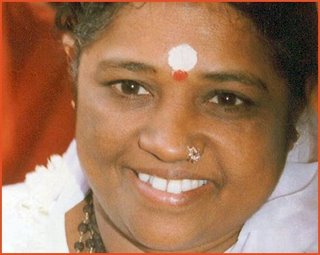 Tara on Tour
Tara on TourThrangu Rinpoche is personal tutor to His Holiness the Karmapa, and is widely revered as a great master, scholar and teacher. I was in Oxford for his visit and, after reading about the life and teaching of Ramana Maharshi, I felt very fortunate to be able to go to his teachings. I didn't attend them all, but was there for the teachings on The Four Thoughts: these are the thoughts that turn the mind to the Dharma. Basically they remind us of why it is important to practice the Dharma. The Four Thoughts are a) precious human birth; b) death and impermanence; c)karma, cause and effect and d) the defects of samsara.
We are reminded of how fortunate we are to have this precious human birth. It is rare apparently - and particularly rare to be born into a body and mind which is relatively healthy and able to listen to and understand the teachings; even more fortunate is to have to the connection with the Dharma and to be able to receive these teachings directly. Once we realise how lucky we actually are to have this human life, we need to know how best to use it.
This is where the following three thoughts help us. When we meditate on death and impermance, it can be a bit depressing because we really face up the reality of what ordinary life is about. Everything changes. Everything that comes into form will eventually decay and/or die. Every type of worldly happiness is subject to change and rarely lasts very long.
When we look at all the many things that happen to us, to others, we wonder what is the cause of good or bad fortune. We wonder what makes things happen the way they do. The teaching on karma, cause and effect states quite simply that every thought, word and action has a consequence - either immediate or in the future. So if our minds are polluted with many negative thoughts and feelings, we are likely to be acting in negative ways as a result - and creating unhappiness for ourselves now or in the future. If our minds can be purified, if we can develop the positive qualities within the mind and diminish the negative ones, then we will be creating the causes for happiness.
Often, however, we attribute happiness to the wrong things. We believe that happiness is dependent on and caused by certain external things - money, physical appearance, relationships, status, fame, possessions, etc. So we spend a lot of time and effort chasing these, and then trying to hold onto them, failing to realise that not only will they not last, but they probably won't bring us that much happiness anyway. These are the defects of samsara.
Reflecting and meditating on these thoughts gives us the motivation to turn the mind towards something that will really bring us happiness - in the short term, in the long term and ultimately will bring us to a state of permanent, stable happiness unaffected by whatever is happening within or around us. That something is the Dharma. The Dharma literally means "Truth" and so it isn't exclusively Buddhist at all - but the path within Buddhism to realise the Truth is very sound and very effective, and can therefore be relied on.
These teachings were followed by what are called the "common preliminaries" but I wasn't there for these ones. I was however, quite by happy chance, back in London earlier than planned and able to attend Thrangu Rinpoche's final teaching before flying back to India at London Samye Dzong. Since I was feeling quite stressed yesterday morning, repeatedly finding myself on a really uncomfortable edge of fear as the wish to deepen this connection, training and work with the Dharma is up against the reality of money and livelihood, I couldn't believe my good fortune when a friend reminded me he was coming.
Last night's teachings were on the Five Buddha Families. Sometimes referred to as the Five Wisdoms. The Five Buddhas represent the purified qualities of the five disturbing emotions: attachment, anger, ignorance, pride and jealousy. The purification of these emotions brings about the corresponding Five Wisdoms. This is because the essence of the negative emotions is in fact wisdom. What is required is simply (!) to purify the negativity distorting the wisdom, and then the wisdom shines radiantly forth.
Taking each one in turn. Rinpoche began with ignorance, which is perhaps the absolute root of our suffering and imperfect human condition. It's because we don't understand the way things are that we create so many problems for ourselves, and experience so much suffering. Once ignorance is purified, all-pervading wisdom shines forth. This is the wisdom associated with Buddha Vairocana who is white in colour and whose symbol is the wheel. All-pervading wisdom is omniscience: the mind is clear of ignorance and can see and understand everything just as it is.
Then he spoke of anger and hatred - and the purified wisdom which is mirror-like. Mirror-like wisdom is clarity; the mind reflects clearly the way things are; there is a sharpness, vividness, brightness. Often when we experience anger or hatred, we are in touch with something quite wise, but the emotions are so disturbed and distorted that we only cause damage, pain and destruction with them. The potential to see things clearly and to cut through the bullshit without negativity is inherent within anger and hatred. It is the Buddha Akshobya who is blue in colour and whose symbol is a vajra who aids us in this transformation.
Pride - the feeling that we are better than someones else - is in essence the wisdom of equality or sameness. In gross and subtle ways, we have many prejudices towards others, believing they are less than us in some way. Once we see the truth, however, we see that we are all equal: that the differences that exist are superficial and don't pertain to the essence of who we really are. The yellow Buddha Ratnasambhava, whose symbol I can't recall, is the Buddha of the Wisdom of Equality.
Attachment and desire - which give rise to greed, grasping and the endless chasing of dreams, goals and objects. Here the Wisdom of Discrimination is the essence. We are able to discern clearly the differences between things and to know them for what they are. In that way, the striving associated with attachment and desire diminishes and is ultimately gone. We appreciate beauty, we recognise it, but there is no more grasping to possess or own it. The red Buddha Amitabha, whose symbol is the lotus, is associated with Discriminating Wisdom.
Finally, jealousy - and the Wisdom of All-Accomplishing Activity. Jealousy is a curiously crippling emotion, one that makes it very difficult to act at all - unless perhaps combined with anger when the combination can be very toxic and dangerous indeed. But generally jealousy seems to bring a kind of helplessness, lethargy and ineffectiveness to our actions. Purifying jealousy leads to great success in the accomplishment of activities. The green Buddha Amogasiddhi, whose symbol is the double vajra, is the Buddha associated with the Wisdom of All-Accomplishing Activity.
Of course the reality of purifying these emotions is pretty difficult! But it's encouraging to know that it's not only possible, but that inherent within each one is the seed of something very positive indeed. One simple method Rinpoche gave us to purify the emotions was to recite the compassion mantra: OM MANI PADME HUNG. This is good to do whenever we can, but in the arising of one of the disturbing emotions, it is particularly good to recite the mantra. This alone will help to pacify and transform the disturbance.




